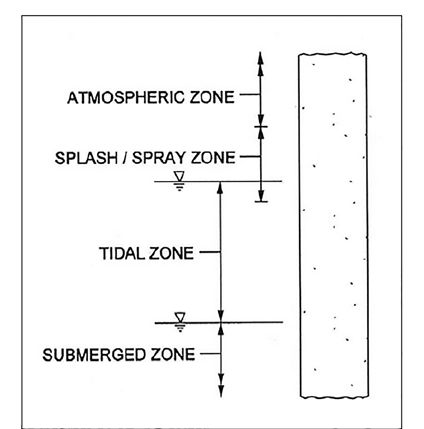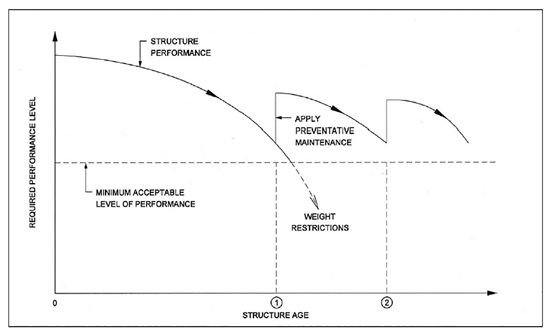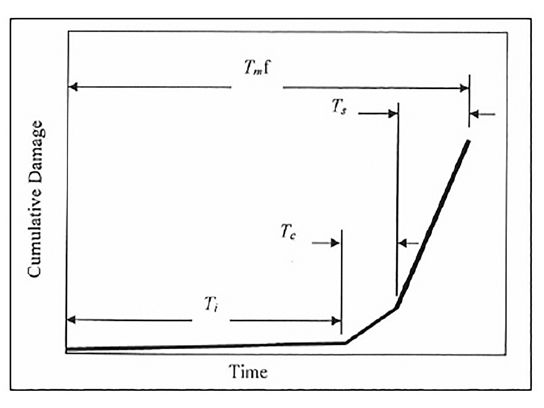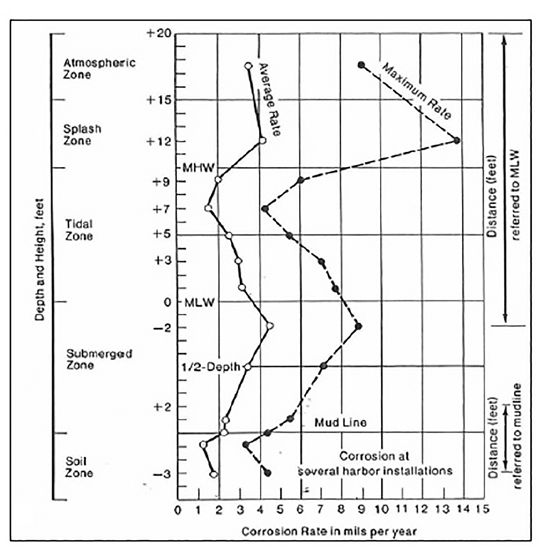USDOT Office of Bridge Technology’s Underwater Bridge Repair, Rehabilitation and Countermeasures
The Federal Highway Administration’s Office Bridge Technology released Underwater Repair, Rehabilitation and Countermeasures in 2010, become more relevant every year.
The following article is excerpted from the report.
Repairs to underwater bridge elements have been successfully completed for many years. However, the increased age of the nation’s bridges and related structures, as well as the increased emphasis in regular underwater inspection since the revisions to the National Bridge Inspection Standards in 1988 indicates an increased need to perform repairs to elements located below or in water.
This manual is intended to serve as a reference for design engineers, construction inspectors, resident engineers, inspection divers and other administrative and technical staff whose work tasks include the repair or rehabilitation of elements of bridges or similar structures located below water. The manual addresses a variety of design and construction issues that must be considered in determining the feasibility of, and selecting the repair or rehabilitation methodology, for underwater projects.
This information can aid in developing cost effective and durable repair and rehabilitation designs.
The Importance of Preventive Maintenance
Maximizing the usable life of the nation’s bridge inventory and related structures requires the effective application of preventive maintenance actions. In addition to the potential cost savings achievable by such activities, significant environmental benefits are realized when structures need not be demolished and reconstructed.
Preventive maintenance is defined by the American Association of State Highway and Transportation Officials (AASHTO) as “the planned strategy of cost effective treatments to an existing roadway system and its appurtenances that preserves the system, retards further deterioration, and maintains or improves the function condition of the system without increasing structural capacity.” Crack sealing, joint repair, seismic retrofit, scour countermeasure installation, and painting are examples of preventive maintenance activities.
Confusion often arises between preventive and routine maintenance. Routine maintenance is defined “as maintenance work that is planned and performed on a routine basis to maintain and preserve the condition of the highway system or to respond to specific conditions and events to restore the highway system to an adequate level of service.” Litter pickup, removal of material that might otherwise clog drains, snow removal, removal of roadkill, and removal of graffiti are examples of routine maintenance activities.
The Safe, Accountable, Flexible Efficient Transportation Equity Act: A Legacy for Users (SAFETEA-LU) Technical Corrections Act, enacted June 6, 2008, changed the Federal Highway Bridge Replacement and Rehabilitation Program to the Highway Bridge Program and placed greater emphasis on the importance of proper, timely bridge preservation. The extension in 2008 of the AASHTO-sponsored Transportation System Preservation Technical Services Program (TSP-2) to include bridge preservation is another indicator of the importance placed on maintenance activities.
Structures located in water are subject to added deterioration, and this is even more severe in a marine (coastal) environment with its ready availability of chlorides. An in-depth treatment of marine deterioration rates is beyond the scope of this Manual; however, some guidance is included. Use of available inspection reports and agency experience of structure deterioration types and rates for local conditions is important in developing a preventive maintenance program.
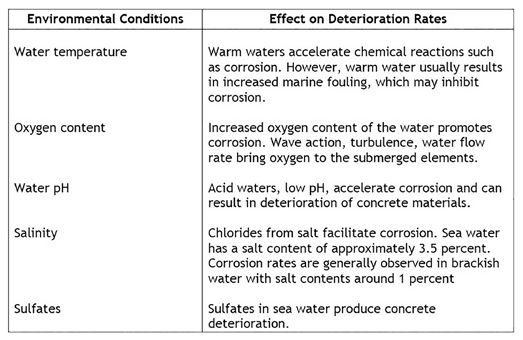
Marine Environment Factors
Structures located in water can be subject to rapid deterioration of their in-water elements such as piles and piers. Freezing and thawing effects, sulfate attack, and corrosion of steel and reinforcing— particularly in salt water—are representative of marine deterioration types whose extent and rate of progress are affected by local environmental factors. The effect on marine structures of the more significant environmental factors is shown in Figure 1. The local combined effects of wind, temperature, and water generally control the deterioration rate of any given structure. Good design, construction, and maintenance can mitigate the extent and rate of deterioration
The deterioration of elements in water is related to the exposure zones along the member as shown in Figure 2. The most rapid deterioration occurs in the splash zone due to the ready availability of moisture and oxygen. The tidal zone, or zones of seasonal water level variation, also experience corrosion rates higher than the atmospheric or submerged zones. These zones are often critical for concrete and steel construction. Areas fully submerged generally see reduced corrosion due to the lower availability of oxygen. Unlike concrete and steel construction, the critical deterioration zone for timber construction extends over the full member length.
Deterioration Models
In order to determine the most cost-effective methods to retain a structure in service, both its existing condition and its expected rate of future deterioration need to be considered. The timely application of preventive maintenance can extend the life of the structure by preventing critical defects to form. This is shown graphically in Figure 3. Application of this approach requires a well defined minimum level of performance, and the ability to predict the rate of deterioration.
For bridges, the minimum level of performance should at least be such that no reduction of live load capacity occurs. Load ratings should be developed from current bridge inspection data.
Estimating rates of deterioration can utilize several approaches. Rates of deterioration are often estimated from past experience with structures of similar type and exposure. A review of the changes in bridge structure inspection data can also provide a means of estimating expected future deterioration. Plots of changes in condition rating with time can be extrapolated to predict at what point critical conditions might be reached and then select when preventive maintenance is needed.
Figure 4 provides a graphical representation of the progress of concrete deterioration due to corrosion. At sometime after completion of construction, Ti, conditions at the reinforcing steel develop that initiate corrosion. As corrosion continues, a point is reached where corrosion products build up, and resulting surface cracking appears, Ts. The cracks allow the corrosion process to accelerate.
Reinforcing steel corrosion leads to further cracking and spalling of concrete until extensive repairs are required to restore the structure. The actual time for these stages to be reached in a given structure depends upon numerous factors such as concrete permeability, cover depth, and chloride content. For preventive maintenance to be most effective it must be applied prior to reaching time Ti.
Steel corrosion losses for piles can be estimated from tables and charts of corrosion rates located in various references. Typical corrosion rate data for carbon steel sheet piling in sea water is shown on Figure 5. Deterioration rates can also be determined analyically utilizing field and laboratory materials test information and computer models such as Life 365® and Stadium® for reinforced concrete structures.
Additional information is available from the Transportation Research Board and the Strategic Highway Research Program. Due to the extent of test data required to provide accurate results from such models, their use tends to be limited to large structures. However, they could also be used to develop more general data applicable to a population of similar (i.e., age, location, visual inspection results) structures.
Deterioration Models
As discussed above, preventive maintenance includes applying a variety of measures to inhibit further deterioration and extend the useful life of the structure. Though major repairs or rehabilitation also provide these functions, preventive maintenance activities are normally lower cost and often applied at regularly established intervals. Typical bridge substructure maintenance activities include protective coatings, crack sealing, local repairs such as patching, and the installation of pile wraps and jackets.
Coatings provide a barrier between the water and the surface of the structural member to inhibit corrosion. The application of coatings is widely used on steel members, generally applied prior to installation. Though coatings can be applied to concrete members, this is not commonly used. Similarly, coatings are not typically used on timber members. For uncoated structures, or where an existing coating has been damaged or is deteriorated, field applied coatings are available. When considering application of coatings to concrete elements, the potential for the coating to debond due to trapped water vapor pressure must be considered.
Coatings for field application in the splash zone and below water are specially formulated, and are typically epoxy or polyester based products. Their manufacturers should certify that the formulations are environmentally acceptable in the intended application. Prior to application, substrates must be properly prepared, and all residue or debris properly disposed of. In some locations proper surface preparation may be impractical to perform within environmental constraints. For instance, high pressure water cleansing or abrasive blasting may cause unacceptable dispersion of old coatings into the waterway.

Splash zone and underwater coatings are applied by gloved hand, brush, roller, or possibly special applicator systems, unless the areas are located within cofferdams. The lifespan of these coatings should be carefully considered as their lifespan will not match coatings applied in dry conditions. Abrasive blasting to clean the surface and provide a surface profile for coating adhesion is essential for proper coating performance.
A major contributor to the deterioration of reinforced concrete is the presence of cracks which allow increased penetration of chloride contaminated or salt water to the reinforcing steel. Sealing cracks which were not corrosion generated will reduce chloride penetration and may delay the onset of reinforcing corrosion. Examples of these cases include pile cracks due to improper installation, volume change cracks in pier shafts, and cracks resulting from impact damage. Where the existing cracks are the result of the expansive forces of corroding reinforcing, sealing of the cracks will not markedly effect the continued corrosion of the steel as by that point the concrete surrounding the reinforcing is already chloride saturated. Sealing of such cracks with a flexible sealant may reduce the rate of corrosion by inhibiting oxygen access and new chlorides, but continued corrosion will occur. The use of rigid sealants at corrosion cracks should be discouraged as a new crack can be expected to develop close to the crack “glued” by the epoxy.
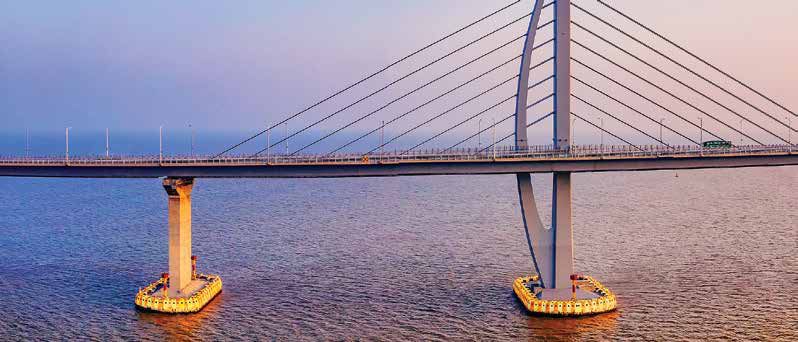
Local patching repairs to concrete structures can be used to reduce the exposure of cracked or spalled areas to further corrosion. When applied to local areas of impact damage such repairs are effective in limiting further deterioration. Where local deterioration is due to chloride induced corrosion, localized patching may be of limited benefit. This is because the development of corrosion induced deterioration indicates the concentration of chlorides at the level of the reinforcing has already exceeded the corrosion threshold value (approximately one and one-half pounds of chlorides per cubic yard). Even if patch repairs remove this contaminated concrete around the reinforcing in the deteriorated area, adjacent areas of concrete at or near the critical chloride threshold remain such that future deterioration of areas adjacent to the local repairs can be expected. Methods for reducing these effects are discussed in chapter IX, Cathodic Protection for Substructures. Cathodic protection can be used to effectively halt further corrosion of both reinforced concrete and steel members.
Application of pile wraps and jackets may be considered preventive maintenance activities if their installation is programmed such as to limit the ingress of chlorides to prevent their reaching threshold values, or stop teredo or limnoria damage to timber piles prior to significant damage accumulation. Whether utilized as a maintenance measure or a repair, selection and installation are very similar. Installation of wraps and jackets is addressed in chapter VIII, Pile Repairs.
Removal of debris accumulations from around piers and abutments reduces lateral loads to the structure and also aids in reducing the local scour effects of the debris. A scheduled program of removal would constitute a preventive maintenance measure. The installation of debris shields or other devices to keep debris from accumulating are other preventive measures.
Many maintenance actions are similar to repairs, except for their timing and extent, and the relevant chapters can be utilized for their selection and installation.
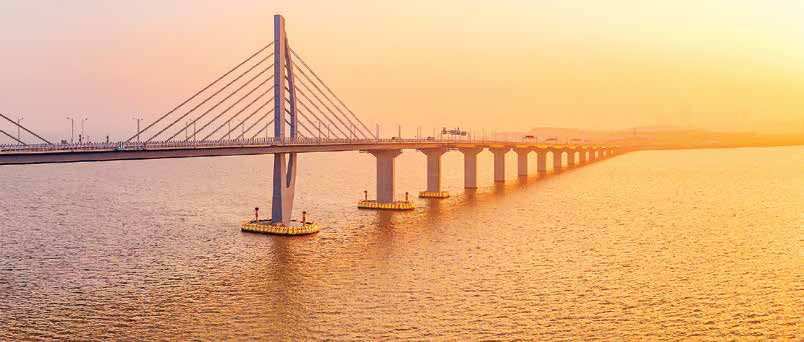
Underwater Bridge Repair, Rehabilitation and Countermeasures was written by Terence M. Browne, P.E.; Thomas J. Collins, S.E., P.E.; Michael J. Garlich, S.E., P.E.; John E. O’Leary, S.E., P.E.; Katherine C. Heringhaus of Collins Engineers, Inc., Chicago, under contract to the USDOT’s Federal Highway Administration.
Republished from Marine Construction Magazine Issue V, 2022







